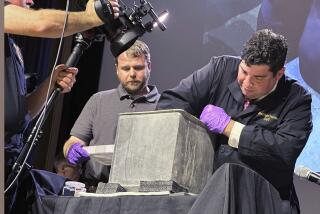Condom in a Time Capsule Is a Revealing Discovery
- Share via
Ever since a 127-year-old condom was found in a time capsule behind the cornerstone of Rochester’s City Hall, the Rochester Museum and Science Center has been flooded with calls.
“I just haven’t been able to figure it out,” said Debra Jacobson, the museum’s public relations manager. “For whatever reason, people seem fascinated by it. We’ve even gotten calls from Berlin, Germany.”
Maybe it’s the realization that, between 200 BC and AD 2000, few things have changed as little as the condom.
Condoms were worn by the ancient Egyptians during ceremonial occasions. Roman soldiers used condoms made of goat’s skin to protect themselves against sexually transmitted disease.
“It’s amazing how much people knew, and the ingenuity they showed in trying to address the problem of unwanted pregnancy and sexually transmitted disease,” said Walter Mesanic of the History of Contraception Museum near Toronto. “Those problems have been with us for a long time.”
And recently the condom has drawn interest again as health officials worry that, even with a national decline in teen pregnancy, the high-visibility lessons of the ‘80s and ‘90s on “safe sex” and avoidance of sexually transmitted diseases haven’t been passed on to the next generation.
*
Rochester’s antique sheath for males, which was in a metal box sealed in 1873 and opened in January, is made of sheep intestine tied with a ribbon at one end. It is not on the official list of time-capsule contents, which included much more mundane items such as seed catalogs and farming implements.
“Somebody obviously snuck it in there,” Jacobson said, which has led museum officials to speculate that it could have been a prank or possibly a protest. Local historians studying the time capsule have noted that the Comstock Act, a federal statute that banned the sale of contraceptive devices, was passed just a few months before the capsule was created. Placing the condom in the time capsule could have been an unofficial form of protest, Jacobson said.
The interest in the antique was so great that the museum put the condom on display late last month and plans to leave it there indefinitely.
Actually, the item is a fairly rare artifact, Mesanic said. His contraception museum is at the headquarters of Janssen-Ortho Inc., makers of spermicide jellies and other birth-control products, and showcases almost every kind of contraceptive device dreamed up over many centuries.
Condom materials through time have included snakeskin, silk paper, leather, linen, tortoise shell, sheep bladders, rubber, latex and plastic.
But the origins of the word condom are not as evident. Some historians say it is derived from the Latin word condus, which means container or receptacle. Others say it is named for a Col. Quondam, an English army doctor who supposedly introduced the gut condom in England in 1645.
The female condom, with the brand name Reality, was introduced in 1994. It has had limited success in the United States but has become popular overseas, particularly in Africa, where women have needed a means of protection from HIV that was less dependent on male cooperation.
More to Read
Sign up for Essential California
The most important California stories and recommendations in your inbox every morning.
You may occasionally receive promotional content from the Los Angeles Times.













